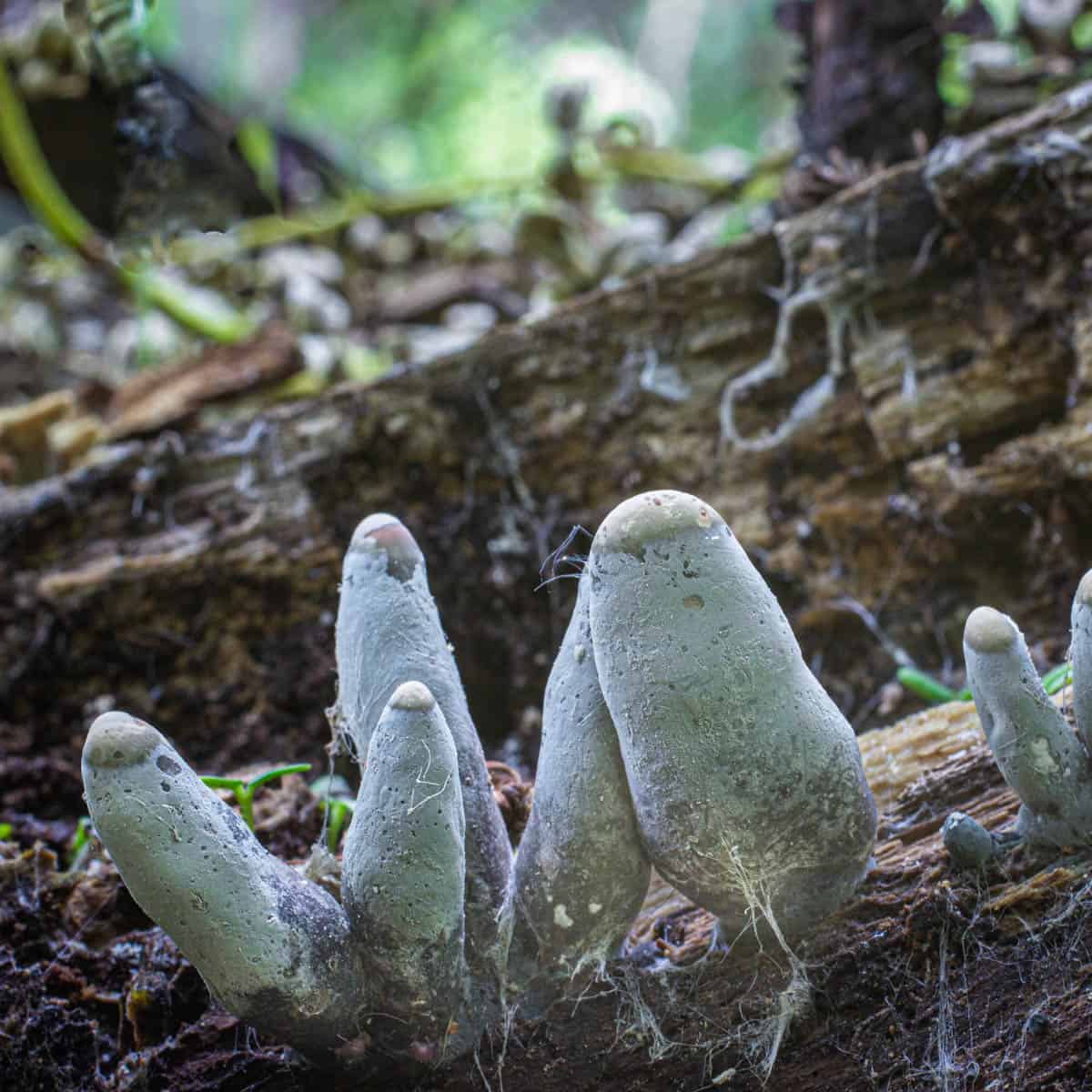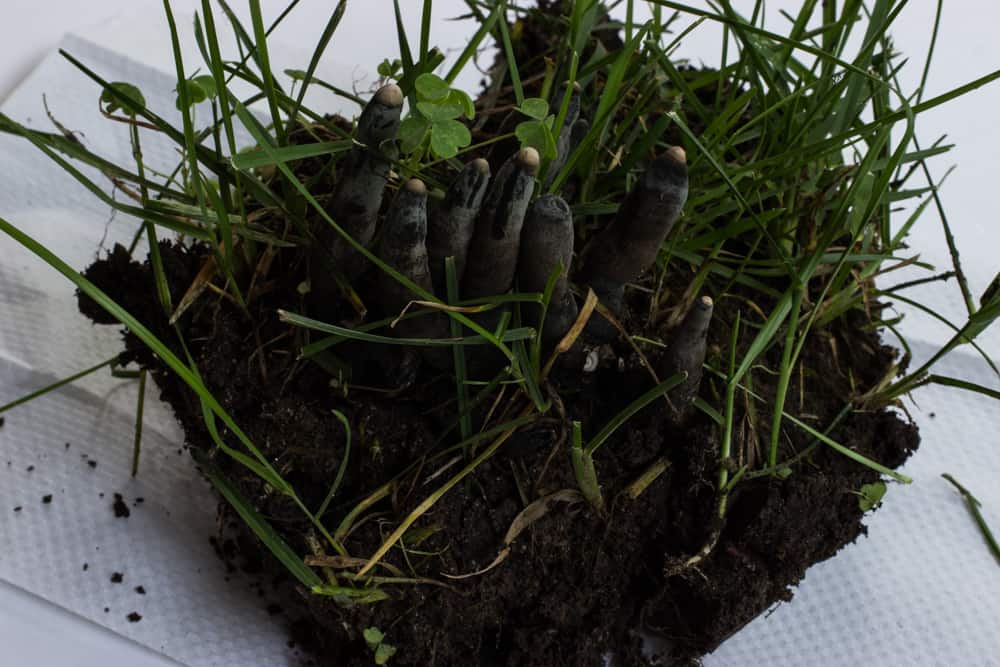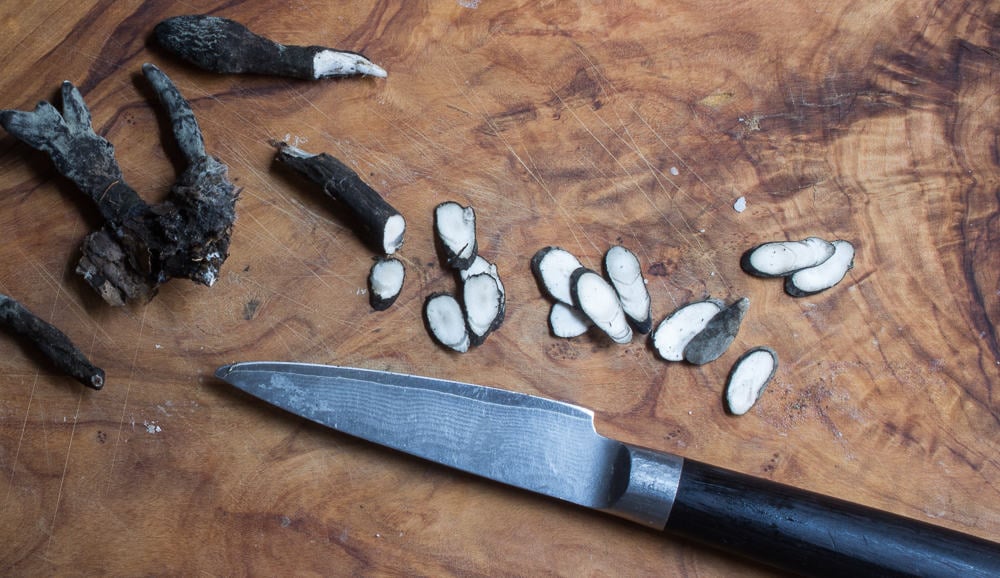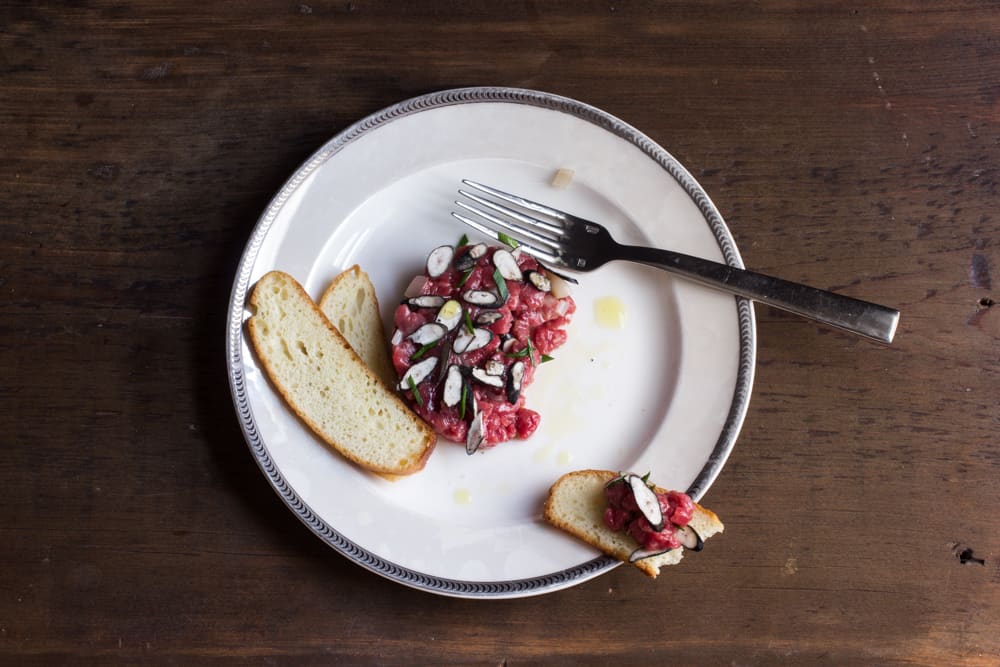Update
As a chef, and mushroom hunter, I naturally want mushrooms to be edible, and delicious. There are a number of mushrooms, like Paragyrodon sphaerosporus, and the man on horseback (Tricholoma equestre) that have been eaten in the past, and now are not recommended for consumption. Unfortunately, after reading a new article published in India, I have to include Xylaria on that list.
I ate the Xylaria a number of times, and had no ill effects, I rather liked them actually. But according to the article below, the researchers concluded that all Xylaria contain amatoxin and phallotoxin, which are the same compounds you don't want eat in some of the most dangerous mushrooms in the world.
That being said, it's frustrating, as I ate these a number of times and had no ill effects at all, which is why I published this post in the first place. There's a lot of great mushrooms out there though, and unfortunately as we learn more with genetic sequencing and the like, mushrooms may here and there be added to and subtracted from our list of things to enjoy.
My aim with these posts is to provide less scientific sounding descriptions of mushrooms since the scientific language of literature can be an obstacle for people just getting into the amazing, edible sport of mushroom hunting, but we still need to pay attention to science. Please see the new article through the link below. Following it is my original post on Xylaria.
Happy Hunting
Article on toxins in Xylaria
ORIGINAL ARTICLE
Dead man's fingers, just saying the name makes your mouth water.
Story goes that last year my friend Sam, who eats all sorts of mushrooms told me about these, he said he tasted some of the young mushrooms, and enjoyed them. Since I'd never heard of them, I made sure to keep my eyes peeled.
Coincidentally, a week or so later one of my friends saw some in his yard and wanted to know what they were, so he dug up the whole clump of dirt and brought them to me. They were the same mushrooms my friend Sam had described, their real name being Xylaria polymorpha.
In the following years, I started to recognize them more and more on my hikes. I generally see them growing around the base of dying trees, sometimes in impressive numbers.
Some research showed what I expected: they're a mushroom thought of as a novelty, definitely not thought to be edible.
The little mushrooms on the little clump of dirt my friend brought to me definitely weren't something I'd pop into a frying pan whole. They were young and fresh. The upper two-thirds were tender, and gave off a nice smell when I cut them with a knife.
Since they're pretty small, frying them up would make them lose too much weight to really be of use for anything, so I sliced them up thinly and ate small amounts for a few days, to make sure I didn't have an allergic reaction. They tasted...good and mushroomy.
Cooking
I know I'll catch a little flak for illustrating them eaten raw. Plenty of mushroomers poo-poo eating wild mushrooms raw. This is partly since mushrooms are composed of chitin, which is difficult to digest, and partly because no one wants to get sick or poisoned.
Cooking helps break things down, as well as making many mushrooms (like morels and Leccinums) safer to eat. There are few mushrooms I'll eat raw, but I do like the occasional porcini sliced thin with salt and olive oil if I find a clean, bug-less button-a fun way to celebrate a rare find.
I'm not here to enter the raw vs. cooked mushroom debate. It's indisputable that cooking mushrooms makes them easier to digest, and safer to consume. I will say though, that I've eaten at least half a pound of these myself over the past two years raw, sliced thin in salads, on toast, on pasta, and plenty of other ways, and had no ill effects.
Of course, the possibility of them doing something weird like concentrating chemicals in your body over years and years like Gyromitra species exists, I suppose, but you could also argue juniper berries, and bay leaves are toxic too, if you consume enough. All things in moderation.
That being said, here's a few things worth mentioning about these:
- You want young specimens, older mushrooms will be covered in spores, and will get limp as they age.
- Dead mans fingers that are completely black will probably be too old to enjoy-look for those that have the small white coloration on the tip.
- If you look close, you'll probably start seeing these all over, I've found the most growing with other mushrooms on decaying wood. where I hunt in Minnesota, this has been mostly dying elms, often in the company of other mushrooms, especially dryad's saddles.
- I've been enjoying them shaved raw over things. Sprinkling them over something warm, like a bowl of pasta will release their flavor a bit as they warm, a bit like cheese blooming when it comes to room temperature.
- Less is more with these, like many mushrooms, combining them with too many ingredients will obscure their flavor completely.





Anon
In Mushrooms Demystified David Arora mentions in the section on mycotoxins that amatoxin and phallotoxin are potent when injected into the bloodstream but are likely destroyed during digestion. He writes that it's amanitin that represents the largest threat in mushroom consumption. Just another data point for your consideration.
Alan Bergo
Hey thanks for that.
Brenda A
I have plenty of deadman fingers in my yard around my dead wood.They said it’s valuable.And says, I have to dry it.
Mal
I just found these in the forest, they have such an excellent smell actually, at least where I live in Berlin. Their hardness was the bigger turn off for me, but I think the ones I found were a bit older. I found them growing directly amongst Xylaria multiplex which just made everything look like one of the levels of hell. I would love to hear someones description of the taste?
Debbie Viess
Re: Peter D's remarks: although I didn't read the Indian paper on amatoxin presence in Xylaria, the Meixner test, which includes a drop of mushroom juice onto cheap newsprint, followed by application of concentrated HCl acid, is a tried and true and very well known, cheap and simple test for the presence of amatoxin. In the presence of amatoxin, the paper will turn blue. Clearly, Peter is unfamiliar with mushroom toxicology.
The test is accurate for the presence of amatoxin in most situations, but was not sensitive enough to detect minute amounts of amatoxin present in the spores of Death Caps. It took advanced and expensive machinery to detect those minute amounts. Currently we have an even better spot test, that is super sensitive and cheap: Amatoxtest. It was only recently developed, and manufacture has been problematic. Up until this point (it won't be on the market again until Septemeber at the earliest), it was readily adapted for use in veterinary hospitals in cases of mushroom poisonings, allowing the detection of amatoxin in both mushrooms and urine, long before liver values started to rise.
Xylaria may well contain amatoxin, but most likely in sub-clinical amounts. Dose makes the poison.
Peter D
I landed here because I was reading an article in the latest issue of Mycologia about Wulingshen, a traditional Chinese medicine produced from the sclerotia of various species of Xylaria. I didn't even know that they had sclerotia.
I read the article claiming amatoxins and to be honest it didn't really stack up in technical terms. Their reference for the 'standard method' for detecting toxins is a book,, The Illustrated Book of Mushrooms. Fine as this book might be, it doesn't constitute a credible reference for a methodology for an academic work. I have not idea what method they might be referring to. There is no detail at all about the paper chromatography except for the mention of a blue spot. Hardly a conclusive result.
Alan Bergo
Thanks Peter. With the way things are I have to play things pretty safe. If I get enough evidence to the contrary I'll amend this post, and I would like to.
Eva
Could consuming microdoses of these toxins in Xylaria actually have a beneficial effect, similar to the snake handler Bill Haast who successfully immunized himself against the venom of all the snakes in his collection by injecting himself with tiny amounts of venom over time? Mithridatism supposedly works best on complex, protein-based toxins, and both phallotoxins and amatoxins fall into this category.
Alan Bergo
Eva, thanks for commenting. This post continues to fascinate me years down the road. So, I've eaten my local Xylaria pictured here, and I have continued to eat them even after seeing the warnings. At the most, I would wager I've eaten half an ounce in a sitting. If they had amatoxin in the quantities people are worried about, I would think I'd have noticed something... I don't know if it's a difference in species, or in the substrate, something they're absorbing, or some other thing (not claiming to be an expert here) but I know that I've eaten the species pictured here annually for at least 5 years now, and...I'm still here. I can't speak to the toxins you're referencing here, but the microdosing is a fascinating prospect to consider. A
Mandi
Hi Alan,
Thank you so much for this article, without it I would not have been able to distinguish the young specimen from the old or even consider eating them. However as with all mushrooms, 100% certainty about edibility is key and I am still uncertain to try them. I have heard from mushroom experts that some mushrooms of the same species can contain more or less toxins depending on where they grow. Thus I was wondering if you have heard anything of such regarding Xylaria? If so, it is pretty much a lucky find, if one keeps harvesting from the same location and I would probably not try it unless I know someone harvesting and consuming them from the same area. Thank you very much.
Stan
Excellent article. I like your attitude and way of thinking…probably because it's so perfectly aligned with my own. How I ate them and my reasons for doing so were also the same as or very similar to yours as was my impression of them. I liked their "mushroomy" flavor, if I recall correctly, even more than that of some of those approved as edible or even 'choice'. Though I also experienced absolutely no ill effects, unfortunately, I'll now be eating these no more. It's disappointing and frustrating as so many of the other mushrooms I come across I am unable to identify with absolutely, 100% certainty.
Keep up the good work. Thanks.
Wram R. C. Accorsi
Please, where can I obtain Dead Man's Fingers for growing these at home? I'm in Brazil.
Alan Bergo
I have no idea, sorry. They're often in yards on buried dead wood, as well as wood in the forest.
Dave
Just ran into your blog on a fact finding mission about Xylaria. Thank you.
Alan Bergo
Thanks Dave. Psssssst, I still eat these too--not dead yet. Some big names in the community have mentioned they think I'm silly, or stupid for suggesting eating such a small, inconspicuous mushroom, but my culinary views on what is deserving of eating is a lot different than most.
Debbie Viess
Intention Eight: no one can eat amatoxin containing mushrooms (aka Death Caps and Destroying Angels) with impunity, no matter where they live!
Host trees don't produce toxins in fungi (and Xylaria do not have a "host tree," anyway). Mushroom toxins are metabolic byproducts of mushroom biology itself. Xylarias are rarely eaten, even if some have done so with impunity. Our knowlege about mushroom toxins grows every day. Some fungi we thought to be edible we then discovered are toxict. Paxillus involutus and Tricholoma equestres are but two examples.
On the other hand, amounts matter, too. I did not read the Xylaria study, but amatoxins may only be present in trace amounts.
Other edible species that contain trace amounts of amatoxins are Boletus edulis, Cantharellus cibarius and Agaricus sylvestris! Odds are that most of us still eat those species.Here is the study that discusses amatoxins in edible fungi:
https://febs.onlinelibrary.wiley.com/doi/pdf/10.1016/0014-5793%2876%2980252-9
It is best to be conservative about edibility recommendations, esp. if you are not just eating them yourself but actually have a platform where you reach and teach others.
I believe that Alan was wise to choose a more conservative recommendation. His goal is to give folks pleasure, not pain!
VICTOR BELFOR
Gyromitra toxins have cumulative effects over days. They do not accumulate over years.
Lucy
I have a lot of dead man fingers a lot of them growing in my yard just recently they bluish/gray with tips who can I sell these too
Alyson Lawrence
Excellent information and well said. Thank you for sharing. Are you aware of any online resource(s) that post current data on mushroom toxicity? I strive to be extremely careful and conservation when it comes to consuming mushrooms. I have multiple field guides and through one is a fairly recent publication, it lists Dead man's fingers as edible and therefore not reflecting current research. I never rely on any single resource for this very reason. Any resources you may suggest would be appreciated. Thank you in advance.
Intention Eight
As you know mushrooms differ from one country to the next. So the indian study may be just for India! Just like tbey can eat angel of death mushroom there but come here to the states and die from eating them. Also what the host tree is a big part of toxins which was not taken into account. Chaga can grow on other trees then birch but not good for medicine or mishroo.s growing on hemlock are not a choice edible bc of the toxins in hemlock. So just some thoughts
Alan Bergo
I know, and you’re totally right, but I’m also the one who has to deal with torch-carrying, angry mushroom nerds when they think I’ve shared information they don’t agree with, so I’ve learned to put caveats and disclaimers up. People love to tell you you’re wrong. 😉
Karen Owen
I just found these I my backybackyard on in a piece of old wood. Ran inside to Google and see what they were. The name fits perfectly! I love raw mushrooms and have never had a problem with them but I'm terrified of eating ones in the wild in case I didn't identify them correctly. Anyone know of a good mushroom/fungi reference book?
Alan Bergo
These will not be in a reference guide, and I can no longer recommend sampling them as a novelty. See the Indian research paper posted in the comment threads and at the top of the post.
Concerned
An indian paper released in Feb 2018 claims that all Xylaria species contain amatoxins or
phallotoxins, so you might want to add a disclaimer to this post.
https://www.researchgate.net/publication/322958969_New_Distribution_Record_of_Five_Species_of_Xylaria_from_Tripura_Northeast_India
Alan Bergo
Thanks for the information, I've ammended the post.
Keith Parker
these also contain compounds that are good antibiotics. they have not been used widely and this makes them effective against MRSA and antibiotic resistant strains of anything really. studies show they increase the effectiveness of other antibiotics commonly used for resistance issues.
BlackSwallowtail
Happy I found your blog when I was looking these up! I just put them in an omelet and it was so good! Butter and green onions really bring them out.
Alan Bergo
Great! I've really enjoyed eating these in small amounts during the season.
Heinz Schirmaier
Just learned something new, thanks!
Debbie Viess
OK, I clicked on this because I was shocked that someone would even want to eat these!
You, Sir, must be one of those MacIlvaneans, who like to try everything fungal!
Good luck with that. It certainly helps to have a cast-iron constitution and a strong stomach. 😉
As to the indigestibility of raw mushrooms ... you have that exactly right. Yes, SOME mushrooms contain toxins which are denatured or otherwise broken down by heat, but mushrooms also contain indigestible complex carbs, unique to fungi, called trehalose. Just like for the lactose intolerant, many people lack the enzyme trehalase to break down these sugars. That is where cooking comes in, to help out our digestion.
Extremely thin slicing of raw mushrooms and "cooking" through methods like using acidic dressings (think ceviche) also helps to break down these indigestible-when-raw mushrooms. Others have made avant-garde raw foodie dishes such as "chanterelle sorbets, " but those are also physically broken down in a blender, first.
Break it down, somehow, before you eat it up!
Debbie Viess
If you want to try this odd "edible" I would suggest both of those tips.
Abigail
Thank You, excellent additional information.
Liz
First, thank you for this article, I had no idea they were even edible, and now I look forward to trying them once I see them again.
I know you don't want to get into it, but the problem with raw mushrooms (including our white store mushrooms) isn't digestibity, it's that they contain carcinogens which are broken down by cooking.
Now, to be fair, we expose ourselves to the sun and cellphones, and many other carcinogens. I personally eat raw mushrooms, on occasion. But I think it's important to make an informed, conscious decision to do something--not ignore altogether.
Finally, the very young and the very old should never have raw mushrooms, as their digestive systems are much more sensitive.
sam schaperow
Its nice to see the topic of their edibility explained by someone other than me or another at MushroomTalk (Yahoo! group). Regarding their raw flavor, I've found them to be remarkably umami-buttery with a tad of bitter. What do you think?
Sam Schaperow
Alan Bergo
Hi Sam, I thought they had a fine, mushroomy flavor raw, I found it very pleasant, if mild.
Heather Hodnicki
Hi Alan,
I really enjoy you're food writing. Especially when it's pertaining to wild edibles and wild mushrooms. I am a health, wellness and nutrition coach. I try to highlight my wild edibles. And wild love some other people's stories too. Especially how to cook, clean and eat them.
I'm wondering if there is anything you would be willing to allow me to share on my website(not live yet) and/or FB and other social media outlets. Reply here, if interested. And I will give you my email. Our you can just reply straight to me. We can chit chat a little more about it. Thank you so much for any consideration.
Alan Bergo
Contact me via email and we can discuss. alanbergo3@gmail.com